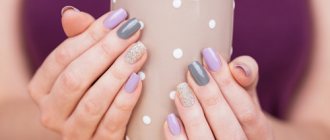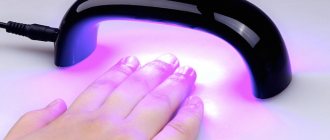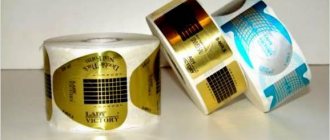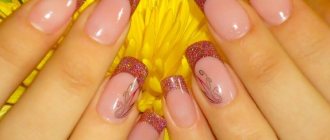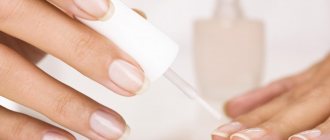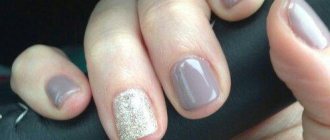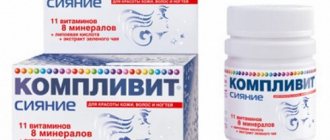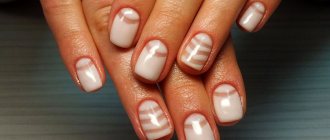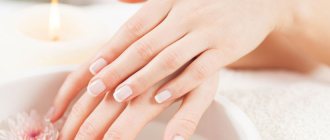Nail extensions, as a popular process and subject to considerable competition among nail service professionals, have over the course of its existence acquired a considerable number of myths and rumors, including those about the dangers of nail extensions.
And if indeed professional masters are much easier to navigate the variety of information surrounding a given topic, then their clients and novice masters have a more difficult time. That is why we asked specialists from the exclusive distributor Kodi Professional in Kazakhstan, which represents materials for professional manicure and pedicure, including the use of monomer, to help us understand the myths surrounding nail extensions.
Myth one
About extensions and its types
It is worth noting that currently nail extensions are carried out using different methods: acrylic, gel, fabric and mixed methods.
In acrylic modeling, powder is used as the main material for the artificial plate, which is mixed with a special liquid, resulting in a mass that hardens quite quickly. Gel extensions are made in a similar way, but only in this case a gel is used as the main material, which dries only under certain conditions - under the influence of ultraviolet radiation.
As for the tissue technique for enlarging plates, it is currently used quite rarely in practice. The principle of creating artificial nails is that the tips are attached to the natural nail using a special piece of fabric, on top of which the desired design is applied.
Speaking about mixed extensions, it is worth noting that to create nails in this way, all the above materials are used: acrylic, fabric, and a special gel. Today, the mixed modeling technique is almost never used.
Is it worth getting your nails done? Reviews about this procedure left by specialists in the field of nail service indicate both its positive and negative qualities. Let's talk about them further in more detail.
General benefits of nail extensions
It is worth noting that regardless of the material with which the artificial coating of the nail plate was created, the extension procedure has a lot of general advantages. Among them, first of all, it is worth mentioning that an artificial plate allows you to hide the ugly yellow tint of a living nail or imperfections in its shape.
Reviews about this procedure often note that with regular implementation, the natural plate begins to strengthen and, in some cases, even correct itself.
A significant advantage of the procedure is that the artificial nail allows you to protect the natural plate from many negative factors acting from the outside.
Cons of extensions
Should I get my nails done with gel or acrylic? In the comments left by those who have previously used this method of increasing the length of nails, it is often noted that if the technician does not work correctly, the nail plate can be damaged. Moreover, minor damage remains after each process of removing the artificial material.
It is worth noting that most women simply turn a blind eye to this list of contraindications, because they are, in essence, insignificant.
Features of acrylic extensions
In reviews of extension materials, you can often find the opinion that acrylic is safer than gel. In fact, this is true, because this substance contains fewer harmful components than the gel.
Acrylic is a material that has increased density and does not wear out for a long time. Moreover, masters often note in their own comments about acrylic nail extensions that it can quickly take the required shape and dry. That is why only experienced craftsmen can work with the coating in question.
Let us next consider the main advantages and disadvantages of acrylic nail extensions.
Disadvantages of extensions
Let's consider the negative consequences of nail extensions:
- After removing the artificial turf, your own plates will have to be restored. They will look unsightly, but after careful care everything will go away.
- If you have a weakened immune system, then the likelihood of natural nails peeling after removing gel or acrylic plates increases.
- Incorrect filing and other mistakes by the craftsman may result in deformation of the plate.
- If the artificial coating peels off from the base, it can be accidentally touched and then the nail is injured. In this case, correction is the best outcome. Often it is necessary to treat injured skin near the plate.
It is impossible to reliably determine that nail extensions are a harmful and dangerous procedure. It all depends on your individual characteristics and your state of health. That’s why it’s so important to turn to conscientious craftsmen.
The impact of artificial modeling materials on health
In this section you will find basic information about the two main types of extensions - gel and acrylic. She will help you weigh the pros and cons of nail extensions.
| Parameter/Material | Gel | Acrylic |
| beauty | Gel plates shine brightly and look glamorous and impressive. They do not change their shade throughout the entire period of wearing. | Acrylic tends to turn yellow over time. Initially, the coating is matte and does not have a natural shine. |
| Convenience | Applying the material is very simple. It levels automatically once it hits the surface. But after polymerization, the gel sometimes cracks. | After the coating hardens, it takes a long time to sand it. Advantages include no need for a UV lamp and high durability. Girls wear acrylic plates much longer than gel ones. |
| Safety | The gel coating provides free access to oxygen. The natural plate underneath continues to grow normally. Among the disadvantages, it is worth noting the need to file off the gel after 2-3 weeks. Sometimes it leads to injury to the nail. | Acrylic contains a minimal amount of substances harmful to nails, so after removing the coating, restoration is carried out in an extremely short time. The disadvantages of this parameter include the strong smell of the monomer, which can be difficult to bear at first and is unsafe for the respiratory tract. |
This table shows the harm and benefits of acrylic and gel nail extensions. These techniques have their supporters and opponents. Therefore, there is no reliable information yet about which coating is more dangerous, but here is what girls write on the Internet.
Advantages of acrylic extensions
Is it worth getting nail extensions if yours are peeling and breaking? Practice shows that acrylic extensions help to cope with this problem - it perfectly strengthens the natural structure of the nail plate, as a result of which it begins to take on a healthy appearance. Moreover, using this extension technique, you can correct imperfections in your own shape of the nail plate.
The advantage of this type of salon procedure is also considered to be that to remove the material there is no need to cut it down - just use a special solution.
Acrylic nails are not capable of causing allergies, since the material is completely non-toxic.
Cons of acrylic extensions
Having considered the advantages, special attention should also be paid to the disadvantages of acrylic extensions, which also occur.
The first and most significant disadvantage of this material is that the procedure for lengthening the nail plate with its help takes about 3-4 hours. In addition, it is worth noting that nails covered with this material grow much faster than those covered with gel. As a result, frequent corrections are necessary.
One of the disadvantages of using acrylic for nail extensions is also the fact that after removing the material, the plate acquires a yellowish tint, which does not decorate it at all.
About gel extensions
Currently, the procedure for gel nail extensions is the most common. Reviews from manicurists note that this material also has excellent strength and, moreover, is easy to use.
Gel is a material that the master applies to tips attached to the nail plates, applying it in several layers. Reviews from professionals note that you can work with such a coating for quite a long time, because in the natural environment it does not dry - this requires exposure to ultraviolet rays.
Let us next consider the positive and negative characteristics of the gel as a material for nail plate extension.
Nail extensions will definitely cause allergies in both the artist and the client.
Nail extension materials can indeed cause an allergic reaction in humans. This primarily applies to hair extension specialists, since they have to work with these drugs day after day. It is very important to know the safety rules and strictly follow them. Unfortunately, not all training courses bother to teach future masters the basic rules of working with chemical compounds, which leads to most problems. A truly professional master will never have such an opportunity, since ensuring safety, both his personal and that of the client, will always come first. But as soon as one inexperienced master makes a mistake and exposes the client to allergic consequences of the procedure, a lot of rumors and speculation immediately appear about the extreme toxicity of nail extensions.
Myth six
Pros of the gel
Reviews of nails made using a special gel very often note that such material looks great on the plates, giving them ideal smoothness and shine - this is precisely its significant advantage over acrylic.
Gel is a substance that allows the natural nail to “breathe” even under the coating. Experts in the field of nail service often notice that ultraviolet light, which is necessary for drying the material, can also have a beneficial effect on the structure of the nails, from which we can conclude that gel extensions are absolutely safe.
Manicurists also draw the attention of their visitors to the fact that gel is a material that does not require polishing after application, as it tends to immediately apply evenly.
Cons of the gel
Speaking about the negative qualities of the gel material intended for nail extensions, it is worth highlighting the fact that the plates created with it tend to crack when there is a sharp change in temperature.
A negative quality of the material is also considered to be that it cannot be removed using chemical solutions. The gel layer can only be removed by cutting. As for the filing procedure, during it the living nail is seriously injured. Also, some women prefer to remove the gel by growing the natural plate until it reaches a certain length. At the same time, it is worth paying attention to the fact that an overgrown extended nail is visually very different from a natural one - this significantly spoils the appearance of the manicure.
How to extend nails using tips
Tips - a model made of plastic or hard cardboard. It is attached to the prepared natural plate. If you use them correctly, there will be no negative consequences. But if extensions are performed using tips by an unqualified technician, then air penetration may occur. It is possible that this will cause the client to develop anaerobic bacteria. In this case, a yellow air trail appears on the surface of the plate, gradually turning into brown. Women often experience pain during this process. All this clearly indicates the appearance of fungus. If this happens, then you should not postpone your visit to the dermatologist.
To the question whether nail extensions are harmful, we can confidently answer: no. It is absolutely harmless, and also gives beauty and the correct natural shape. But this is possible if high-quality nail material is used by a skilled and experienced nail technician, as well as in cases where the client does not have individual intolerance and follows the rules of wearing extended nails. But it’s up to the client to decide whether to have nails extended or not.
Should I get my nails done at 13?
Is it possible to do extensions for girls who are still in their teens? Experts in the field of medicine, as well as in the field of providing nail services, often note in their reviews that such a procedure is contraindicated at this age.
Should I get my nails done at 14 or at an earlier age? When answering this question, doctors often pay attention to the fact that during this period of life, a person’s fingers are not yet sufficiently formed, which can lead to subsequent deformation of the nail plate.
Nail treatment
The doctor should tell you how to cure plates affected by fungus. If 1-2 nails are affected, it is enough to use local preparations. Most often, a specialist can prescribe Levorin, Triderm, Exoderil ointments. When local treatment does not overcome the disease, it is in an advanced form, or the fungus has penetrated into the nail growth area, Nystatin or Diflucan tablets are included in the treatment regimen.
In parallel, you can carry out treatment with folk remedies:
- Before going to bed, lubricate the plates with iodine, and wipe them with a 3% hydrogen peroxide solution in the morning. Then, soak gauze in penicillin and wrap it around the affected nail;
- pass a few cloves of garlic through a press. Add 5 milliliters of sunflower oil to the pulp. Lubricate the damaged surface;
- make a weak solution of potassium permanganate, steam your fingers a little. Apply onion or hot pepper juice to the plates.
If you have a question about how to treat mold, it is also better to contact a specialist. Ointments “Loceryl”, “Lamisil” and “Batrafen” are considered effective.
Therapy can be supplemented with popular traditional medicine:
- steam the handles in a warm soapy solution, then lubricate them with pharmaceutical birch tar;
- Dissolve 3 grams of baking soda in 250 milliliters of warm water. Lubricate your nails. After drying, treat the plates with celandine oil.
Advice. During treatment, avoid any manipulation of your nails. Only medical procedures are permitted.
Contraindications for extensions
It is worth noting that in fact there are a number of contraindications to nail extensions. These include, first of all, individual intolerance to the materials used to carry out the procedure.
Nail extensions are not recommended for girls who have fungal diseases. Also, serious contraindications are the presence of a woman in a state of pregnancy, as well as during lactation.
Reviews from experts regarding the nail extension procedure say that in case of certain diseases, it is best to avoid extensions, since due to the nature of the processes in the body, the material will not adhere very well. A number of such diseases include all those that affect the digestive, endocrine, and excretory systems. Moreover, practice shows that the material does not adhere well during the period of use of antibiotics, as well as during and after a course of chemotherapy.
Fingernails are coming off: is it worth extending them? It is worth noting that the described situation is also a significant contraindication to the procedure, since in this case the process of its treatment is vital for the nail plate.
Is it worth getting your nails done before going to the seaside? This is not prohibited, but it is worth remembering that while swimming in salt water, the nail plate is naturally strengthened due to the ingress of useful nutrients into its structure. This will not happen in a situation with extended nails.
The truth about nail extensions
Since the extension procedure is at the peak of popularity, it has acquired many myths. Masters in beauty salons insist that it is absolutely safe and does not worsen the condition of its own plates. On the contrary, the natural nail stops peeling and acquires the correct shape and direction of growth.
Scientists, in turn, scare the public with statistical data indicating that a large number of women with cancer at one time were fond of nail extensions.
In their opinion, the cancer could have been caused by ultraviolet radiation from the lamps used to dry the material. In fact, the risk is minimal if the technician takes into account the service life and changes the equipment in a timely manner.
I propose to briefly familiarize yourself with the main controversial points of the procedure:
- acrylic or gel. The “war” between them has been going on for years. Which is actually better? You will be surprised, but the materials belong to the same chemical group called acrylates. Their difference is only in the method of drying and removal, but the effect on the nails is absolutely the same;
- benefit or harm. Artificial plates protect natural plates from the aggressive effects of external factors, promote shape correction, and prevent delamination;
- constant and complex care. In fact, it's the other way around. You just need to know what nail correction is after extensions. You will need to see your therapist every 2-4 weeks. He will remove excess length, lay out material at the edge of the overgrown nail, correct the shape and remove cuticles.
Important. Many girls think that extended nails can be removed on their own, but this should never be done. Your inept and careless actions can easily damage the plate or cause serious injury.
Is the experience of the master important?
Is it worth getting your nails done at once? It should be noted that there is nothing wrong with this procedure if an experienced and well-trained specialist takes on the matter. It is worth noting that the qualifications of a manicurist are actually of no small importance, because it is precisely due to the lack of one that most often causes irreparable damage to the nail plate, which leads to disastrous consequences.
In what ways can an inexperienced master ruin his feet? Let's look at the most striking mistakes that only a beginner can make:
- lack of knowledge about contraindications for extensions;
- excessive cutting of the plate;
- use of low quality materials;
- causing injury during the removal of insoluble materials;
- incorrect modeling of nail geometry.
Reviews from fans of artificial nail lengthening often note that when choosing a nail technician, you should give preference to proven specialists in this field, who usually work in popular salons.
Harm
When applying extensions, every girl runs the risk of ruining her natural nails. Therefore, questions about whether nail extensions are harmful should be considered at the stage of preparation for the procedure. A negative impact can be caused by the fault of the master, from the process itself, as well as from the material used or the characteristics of its application.
Damage due to the fault of the master
Often, all sorts of risks are complicated by a lack of experience or dishonesty of the master. The final beauty of the plates and the health of the nails in the future depend on it. If you choose the wrong nail salon, the damage to your nails grown there can manifest itself in the following:
- Excessive cutting of the natural plate. If the artist uses a file that is too hard or takes too long to file the nail instead of simplifying the task by sanding, then the living nail may be shorter than necessary. This affects both the quality of the final work and the health of the nail.
- Incorrect modeling of nail geometry. When a master makes mistakes by making incorrect calculations, the risk of cracks or plate breakage seriously increases. Moreover, scrapping threatens not only the artificial plate, but also the natural one.
- Use of low-quality materials. Some craftsmen use cheap materials of low quality. This affects the appearance of the plates and their durability, and can also seriously harm your fingers.
- Ignorance of contraindications. Some masters may not even pay attention to obvious problems that prohibit extensions. For example, if the plates are too thin and weak, they may still perform the procedure. As a result, a person will feel pain, get damaged nails and may experience the appearance of wounds.
- Injury caused when removing insoluble materials. If a technician works with a sanding file for too long, he runs the risk of touching the real nail. In such situations, the main damage will be caused to appearance.
It is important to take the issue of choosing a master for such work seriously. It is advisable to give preference to proven specialized salons, where clients are served by experienced manicurists.
Main harm
Not everyone experiences harm from nail extensions. But if you repeat this procedure regularly, the risk of encountering it will increase. Even with the involvement of an experienced master, a girl may suffer from the following problems:
- Injuries to the nail plate with regular repetition of the procedure. After filing the extended plate, it will take 4 months to restore the nail. If you neglect this rule, injuries will appear in the next six months. Cracks, yellowing and delamination are most likely to occur.
- Negative influence of materials. Even when using good materials, there is a risk of encountering a fake that contains harmful components. The liquids evaporate and poison the air, from which the master himself also suffers. They also cause injuries to the nail plates.
- Nail deformation due to lack of oxygen. It is believed that nails do not need air, because... they do not have a breathing apparatus. However, the production of keratin to build nails requires some oxygen. If it is not there, then the extended nail will be deformed and become curved, which will ruin the beauty of the manicure.
- Stopping the production of the protective layer. When applying various artificial materials for a long time, the formation of natural protection is suspended, and its remnants are removed. For this reason, the real nail becomes extremely vulnerable to the negative influence of the external environment and may turn yellow, thin, or peel.
- Development of bacteria. Microorganisms develop under a layer of artificial materials. This is especially susceptible to those people who often repeat the procedure of extensions or applying different gels to their nails. Bacteria remain in the formed layers, where their effect on the skin or plates is not even noticeable.
It is difficult to say for sure whether extended nails are harmful. Much depends on random factors and the master. But there is a difference in the materials used.

